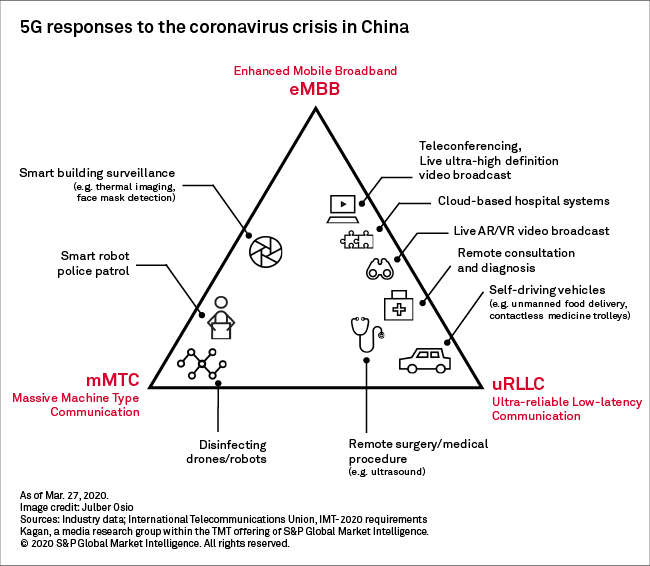S&P Global Offerings
Featured Topics
Featured Products
Events
S&P Global Offerings
Featured Topics
Featured Products
Events
S&P Global Offerings
Featured Topics
Featured Products
Events
Banking & Capital Markets
Economy & Finance
Energy Transition & Sustainability
Technology & Innovation
Podcasts & Newsletters
Banking & Capital Markets
Economy & Finance
Energy Transition & Sustainability
Technology & Innovation
Podcasts & Newsletters
S&P Global Offerings
Featured Topics
Featured Products
Events
Blog — 1 Apr, 2020
From thermal imaging 5G robots to sterile self-driving cars, China demonstrated how certain 5G technologies can assist the world's response to the coronavirus crisis.
Being severely infectious, the 2019 coronavirus prompted health organizations worldwide to advise physical-distancing and stay-at-home measures to curb infections. This put wireless technologies in the spotlight, as people sought ways to stay connected and continue their lifestyles within the confines of their homes.
The coronavirus pandemic set the stage for testing some of 5G's promising features, such as connecting a myriad of devices while maintaining high speeds and minimal latency. Mainland China, the first market affected by the crisis, developed many 5G-based responses that other 5G-capable countries, such as Italy and the U.S., could emulate to help fight the disease.
READ MORE: Sign up for our weekly coronavirus newsletter here, and read our latest coverage on the crisis here.
For starters, there are three main use case scenarios for 5G as defined by the Radiocommunication Sector of the International Telecommunication Union, in September 2015 and stipulated by Release 15 of the 3rd Generation Partnership Project in December 2018.
Enhanced Mobile Broadband, or eMBB, refers to use cases that require the delivery of massive amounts of data at high speed and mobility, such as downloading gigabyte-sized files in a second. Ultra-reliable Low Latency Communication, or URLLC, covers latency-sensitive applications that require little to no disruption, such as self-driving cars. Massive Machine Type Communication, or mMTC, enables machine-to-machine connections at the scale of a whole building or even a whole city.
China's 5G responses to the coronavirus crisis covered all three scenarios.
In the epidemic center of Wuhan, China's big three carriers, China Mobile Ltd., China Unicom Ltd. and China Telecom Corp. Ltd., set up 5G base stations to deliver wireless connectivity to two field hospitals set up by the government. Starting Jan. 27, the three carriers broadcasted the construction of the two field hospitals live through 5G using 4K high-definition and 360-degree panoramic virtual reality cameras. Technology companies Huawei Technologies Co. Ltd. and ZTE Corp. and broadcast companies such as Tencent Holdings Ltd. and China Central Television assisted in the live 5G broadcast that garnered more than 150 million online viewers.
This eMBB and URLLC use case was replicated on two more occasions: the streaming of aid and donation arrivals in Wuhan Tianhe International Airport starting Feb. 5 and the large-scale VR broadcast of cherry blossom resorts all over China starting Feb. 12.

As lockdowns and outdoor restrictions became the norm in most regions in China, 5G devices took over services that would have normally required personnel. On Jan. 30, agricultural drone manufacturer XAG Co. Ltd. and Huawei converted 2,600 smart robots and drones into disinfectant sprayers — the closest real-life example of a 5G mMTC use case. Robot manufacturer CloudMinds Inc. also donated 5G robots to hospitals in Wuhan on Feb. 4 to assist with consultations, disinfection, cleaning and medicine delivery.
5G robots also found use in smart surveillance. On Feb. 6, China Mobile deployed 5G-powered thermal imaging robots in major cities in China that could do rapid, noncontact body temperature measurement within 1 meter-10 meters. The robots sound an alarm and transmit data to authorities using 5G when abnormal temperatures are detected. China Telecom launched a similar solution Feb. 14 that added the ability to use high-resolution cameras to identify people not wearing face masks in public places.
5G URLLC use cases such as the deployment of autonomous vehicles helped minimize human contact and the risk of disease transmission. Technology giants JD.com Inc. and Baidu Inc. used unmanned vehicles to transport medical supplies and deliveries. Food delivery and e-commerce companies Meituan Dianping and Suning.com Co. Ltd. also deployed driverless cars to deliver goods to residents under quarantine.
While these applications benefited from the high-capacity, low-latency and connectivity-dense 5G networks in mainland China, they do not necessarily have to use 5G. Similar applications of drones and robots using 4G can be seen in Hong Kong, Italy, Philippines, Spain and the United Kingdom. Huawei, in particular, said March 27 that such solutions to combat the coronavirus disease could also work on existing networks in India.
5G, however, is truly essential in telehealth applications. 5G eMBB and URLLC scenarios made it possible for doctors in China to remotely diagnose COVID-19 in patients situated miles away. China Telecom and ZTE conducted China's first 5G remote diagnosis of COVID-19 on Jan. 26 between West China Hospital and Chengdu Public Health Clinic Center of Sichuan University. All three carriers followed this by similar remote 5G consultation and diagnosis services in multiple hospitals in China.
On Feb. 2, China Telecom pushed 5G telehealth a notch higher by successfully performing a remote ultrasound between Zhejiang People's Hospital in Hangzhou and No. 1 People's Hospital in Tongxiang. The procedure involved the remote operation of a robotic arm and delivery of high-definition ultrasound images up to 2 GB in size in real time.
So far, mainland China has been the only market to extensively use 5G applications in responding to the coronavirus crisis. South Korea, which also has considerable expertise in 5G, did not use 5G to a similar extent in dealing with the disease. Cambodia could follow China's footsteps as local carrier Cellcard announced Feb. 27 the deployment of four remote 5G consultation and diagnosis sites in the capital Phnom Penh.
Click here(opens in a new tab) to see the full report, including a list of 5G responses to the coronavirus crisis.
Wireless Investor is a regular feature from Kagan, a media market research group within S&P Global Market Intelligence's TMT offering, providing exclusive research and commentary.

